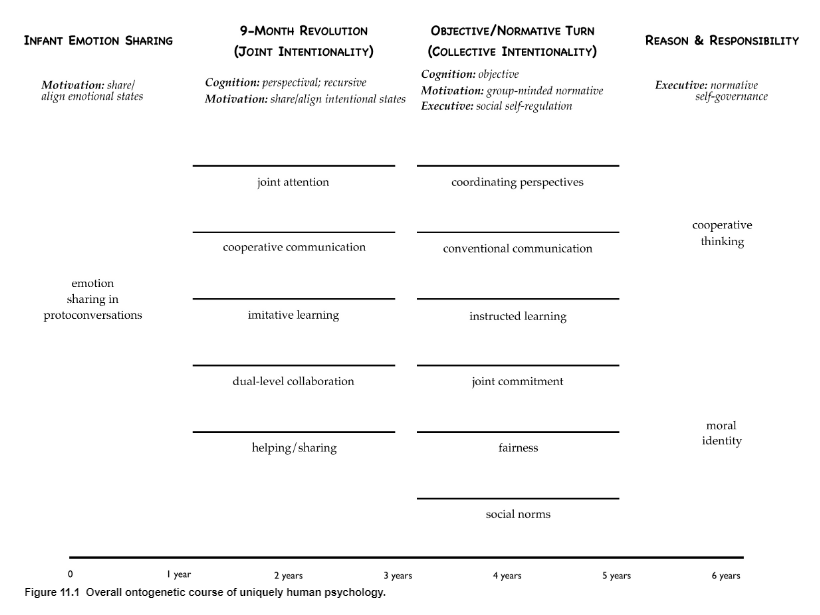Becoming Human
This book attempts to answer what it is about humans that is unique, what distinguishes our species from others. Tomasello builds on Vygotsky’s theory of development and injects an evolutionary aspect to it, morphing it into a theory of shared intentionality. It introduced me to the concept of ontogeny, or development theory, of humans.
In summary form, the theory is that human ontogeny is a constructive process involving maturation, experience, and executive self-regulation. The maturational framework begins with general great ape cognitive and social ontogeny, but then also incorporates evolutionarily new and specifically human capacities that transform the process. There are two sets of specifically human capacities.
Joint Intentionality Motivation: the motivation to socially affiliate and bond with other individuals (especially adults) by sharing / aligning psychological states (emotions, goals, attention, knowledge) with them. Cognition: the cognitive capacity to create a joint agent “we” with other individuals, creating the possibility of taking the perspective of others, including recursively (aka the dual-level structure), and relating to others second-personally as equals.
Collective Intentionality Motivation: the group-minded motivation to affiliate with and care for the social group by respecting and conforming to (aligning with) its conventions and norms (that is, under the pressure of obligation). Cognition: the cognitive capacity to form a group-minded “we” and so to participate in conventions, norms, and institutions, and to view things from “objective” and normative perspectives.
As these new capacities enter into ontogenetic pathways, they make possible new forms of sociocultural interaction and experience—such as joint attention and dual-level collaboration, along with their associated perspectives and roles—leading to new kinds of psychological attitudes, such as the senses of fairness and guilt.
I think where this book is so interesting is that it seems like it borrows from a philosophical idea in joint intentionality and rigorously tests it. And there is certainly a parade of studies, one after the other. It makes the work feel unassailable, and while many studies are from Tomasello himself, surely if there is this much literature backing up Tomasello’s claims, there is something to it.
But the core idea that I hadn’t ever really thought about, that what makes humans uniquely human is their ability to collaborate, is ground-shaking. You can cast all processes in this new light – everything we learn is about this collaboration, this in-group, out-group type of membership. Tomasello does exactly that, each chapter focusing on a component of this type of collaboration: social cognition, communication, cultural learning, cooperative thinking, collaboration, prosociality, social norms, and moral identity. The work is a culmination of dozens of years of research, and despite being a neophyte to the discipline, has the feel of being a definitive work to me.
I imagine I’ll keep coming back to the core ideas over and over again in how I frame things. It might have a similar effect that Harrari’s work, and the shared construction of myths, had on me a few years ago. These two ideas seem to interlock.
Two Takeaways
- Collaboration, in the form of joint intentionality and shared intentionality, is what separates humans from animals. Joint intentionality is the capacity for two humans to collaborate, and shared intentionality is a larger human capacity to collaborate typically manifesting in patterns of behavior called culture.
- Tomasello adapts Lev Vygotsky’s sociocultural theory of cognitive development, where human development is a socially mediated process where children acquire their cultural beliefs, values, and problem-solving skills through collaborative dialogues with more knowledgeable members of society, and contrasts this uniquely human developmental process with our closest relatives, great apes. This book is an answer to what makes humans unique, and it is this collaboration and the linguistic, pedagogical, and psychological processes that reify it.
